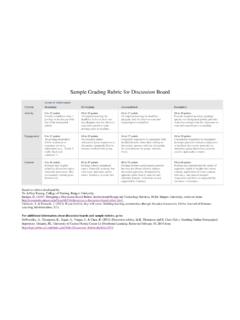Transcription of Techniques to engage the online learner - AABRI Home Page
1 Research in Higher Education Journal Techniques to engage the online learner Virginia Junk University of Idaho Nancy Deringer University of Idaho William Junk University of Idaho ABSTRACT. A survey conducted by the Sloan Consortium in Fall 2007 revealed million students were enrolled in online classes which is a 12 percent increase over the number reported in 2006. (Allen & Seaman, 2008). The current economic downtown has also created a positive impact on the numbers of online learners . To effectively serve these students, educational materials must be developed, structured, and distributed using pedagogy that best supports online learning. This paper is a review of the recent literature regarding electronic pedagogy the term for preparing materials for the online learner . A list of twenty reported components for success is identified and then augmented with what the authors have learned during seven years of teaching online WebCT and Blackboard classes.
2 Examples of course pages that illustrate the application of selected concepts are included as well as suggestions for how to implement these concepts. Implications for future online instruction, based on the evolving electronic pedagogy are also provided. Keywords: online learning, electronic pedagogy, distance education Techniques to engage , Page 1. Research in Higher Education Journal INTRODUCTION. The National Center for Education reported over 56% of higher education institutions in the United States offered distance education in the 2000-2001 academic school year with 90% of the institutions using asynchronous internet instruction (Natriello, 2005). In 2003, million students were enrolled in online classes with institutions projecting 2004 enrollment to exceed million students (Saba, 2005). A survey conducted by the Sloan Consortium in 2007 revealed million students were enrolled in online classes which is a 12% increase over the number reported in 2006 (Allen & Seaman, 2008).
3 There are a numerous learners whose only feasible way to obtain information or higher education courses is from online sources. The emergence of online learning enables us to reach audiences that previously were hard to serve. Cooperative Extension and higher educational institutions see e-learning as a way to expand their offerings to those who would otherwise not have access (Naidu, 2003). It is also thought that with the economic downtown, higher fuel costs and unemployment may cause more students to opt for online courses. online learning allows students more workshops or classes to choose from and results in a greater flexibility in personal scheduling. In order to best serve these audiences educational materials must be prepared that are developed, structured, and distributed using pedagogy that targets effective online learning. As in the traditional classroom, it is important for instructors to be knowledgeable and responsive to the needs of learners , developing an understanding and appreciation for their students.
4 When creating online materials, it is particularly important for instructors to understand the pedagogical differences that exist between face-to-face and online learning situations. Learning should move away from a teacher-centered to a student-centered approach using inquiry and project-based learning activities (Lowes, 2005). online learning should involve three types of interaction: 1) learner to learner 2) learner to content and 3) learner to instructor (Misanchuk & Anderson, 2001). The goal of an online program should be to provide an environment which actively engages students in the learning process and promotes independent learning where students take ownership of their work. The role of instructors shifts, placing more emphasis on facilitation where the instructor provides the structure for the course with scheduled assignments and due dates, and guidelines on how to complete assignments (Lowes, 2005).
5 WHAT IS KNOWN ABOUT online EDUCATION INSTRUCTORS. Some of the same things that make for successful face-to-face instructors also apply to successful online instructors. These things include good communication and organizational skills as well as the ability to use questioning strategies which promote critical thinking skills in students (Davis & Roblyer, 2005). However with online teaching, instructors need to be able to interpret students' needs through nonverbal cues since verbal cues are unavailable. One means of accomplishing this task is to watch for changes in the level of student participation. Initially some students may experience difficulty getting started with a course. These difficulties can discourage them significantly. Instructors who anticipate these difficulties will be able to better assist their students and enhance the online learning experience (Palloff & Pratt, 2003). Successful instructors find ways to get students involved by using facilities such as chat rooms or threaded discussions on a discussion board.
6 Instructors can pose questions that require students to use higher order thinking skills (Junk and Culbertson, 2004) and then post responses Techniques to engage , Page 2. Research in Higher Education Journal to students' postings that challenge students to further explain their viewpoint. Posing questions that are open-ended in nature can encourage higher level thinking such as evaluation, analysis and integration. One of the most important determinants of the quality of student experiences and learning outcomes in an online program is the quality of interactions between the students and instructor. When instructor involvement is low, outcomes are not as positive as in a face-to-face course. However, when the instructor's interaction level is high, this can enhance the student's learning experience. Learning outcomes are more likely to be reached with a high level of interaction (Zhao, Lei, Lai & Tan, 2005).
7 One indicator of quality of student experiences is the course evaluation scores from student evaluations. Some find that online course evaluation scores are higher than face-to-face courses (Junk and Culbertson, 2004). The online instructor assumes four roles in the teaching / learning process. The first role is pedagogical. In addition to being a content provider, the instructor also becomes the content facilitator (Bonk & Dennen, 2003). The instructor asks questions, encourages students, and designs instructional activities. The second role is a social role. The instructor needs to provide a friendly, nurturing and safe environment, which enhances communication through discussions and feedback. The third role is a managerial role, where the instructor coordinates assignments, specifies due dates and expectations, and responds with timely feedback. The instructor should inform learners of their role and responsibility before the course begins, making sure that students are familiar and comfortable with using the required technology (Patsula, 2001).
8 While it is important for the instructor to challenge the learner , create curiosity, and to help learners achieve personal learning goals, it is essential to avoid information or assignment overloading for the sake of the student and the instructor (Patsula, 2001). The fourth role is technological, providing tutorials or information regarding the use of technology contained on the web site (Bonk & Dennen, 2003). Palloff & Pratt (2003) found that in order to keep learners engaged, a typical online class will require an average of 18-19 hours per week of instructor activity. How much time it takes varies with the number of credits or sessions, how many students are participating, and how much commitment to the course the instructor is willing or able to make. Much of this time will be spent making personal contacts with students, either via threaded discussion or by email. By printing student's postings from the discussion board, the instructor can then read them away from the instant response mode of the threaded discussion.
9 This gives the instructor time to reflect on the student's thoughts and ideas. When responding to a discussion post, it is effective to formulate it in a text document, spell-check it, and then cut and paste it onto the discussion board. While this process can be time consuming for the instructor, it is vital in modeling professional writing for the students. Keeping the threaded discussion flowing engages the learner to look forward to checking postings to see who has responded. It builds connections when students get a timely response they know someone is out there and while it is not as quick a response as face-to-face the teacher can wow the student customers with instructor reaction time (Junk and Culbertson, 2004). Providing this type of quick response means that an instructor and their students can work 24/7 the Web is always accessible. WHAT IS KNOWN ABOUT online EDUCATION STUDENTS. For students to be successful online learners , they need to be self-motivated, well- organized, and capable of being independent learners who are reflective and critical thinkers Techniques to engage , Page 3.
10 Research in Higher Education Journal (Lowes, 2005; Patsula, 2001). Students who are open-minded and willing to share information regarding their lives, work, and educational experience are more able to connect with other students as well as apply new knowledge to their past experiences. When they encounter a problem or lack clarity with an assignment, they must be willing to communicate with the instructor. Students need to commit time to course studies on a weekly basis and not assume the online version will be easier than a face-to-face course a common misconception. Since collaboration is an integral part to quality online courses, students must be able and willing to work with other students. Finally, students need to be internet and computer literate, and willing to become familiar with the tools used on the course web site (Palloff & Pratt, 2003). The online learner needs continual reassurance that they are on-track with postings and assignments.


















